Subjects:
- Crankcase ventilation general
- Crankcase ventilation valve
- Blow-by gases
- Versions of crankcase ventilation and crankcase ventilation
- Oil separators
- Electric heater for crankcase breather
- Common Crankcase Ventilation Problems
Crankcase ventilation general:
Crankcase ventilation is a system that vents vapors from the crankcase to the engine's intake manifold. In addition to the engine oil, the oil pan also contains air. This air is mixed with oil vapors and a minimal amount of combustion gases that pass the piston rings in the air sump end up. We call this the “blow by” gases. This vapor must not be released into the open air. If this has been done deliberately, as in the past with old engines, we call it Negative Crankcase Ventilation. However, this is bad for the environment, the vapors consist of combustion residues, water vapor and petrol vapour.
Today, the vapors are fed through hoses and tubes to the engine's intake tract (visible in the image opposite). The crankcase vapors are thus sucked in by the engine and then participate in the combustion process. After they are burned, they are no longer harmful. We call the fully closed crankcase ventilation a “Positive Crankcase Ventilation”, abbreviated as PCV. The positive crankcase ventilation is equipped with a so-called PCV valve, which regulates the pressure to the crankcase.
Crankcase ventilation and crankcase ventilation are often confused. There is an essential difference between crankcase ventilation and crankcase ventilation:
- with crankcase ventilation, the crankcase vapor is discharged and fresh air is supplied;
- with crankcase venting, only the crankcase vapors are extracted.
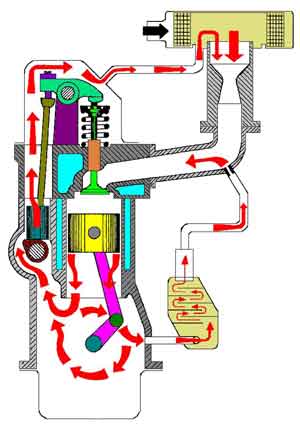
Crankcase ventilation valve:
The crankcase ventilation is both a check and pressure control valve, which discharges the excess pressure from the crankcase ventilation to the inlet of the engine, but closes in the opposite direction. In most cases, the crankcase ventilation valve is designed as a spring-loaded diaphragm valve that keeps the underpressure in the crankcase at approximately 0,02 to 0,03 bar relative to the outside air pressure.
When this PCV valve is opened, the water vapors and blow-by gases are absorbed in the inlet valve and co-combusted in the cylinder.
The crankcase ventilation valve is connected to the outside air on one side and connected to the intake manifold on the other side. The goal is to maintain a low, constant pressure in the crankcase with varying pressures in the intake manifold.
- At idle speed, the pressure in the intake manifold is low (underpressure). The valve is almost closed;
- When accelerating, the throttle is opened a bit and then the air pressure in the intake manifold rises (less underpressure). The valve opens a little further.
When the valve is opened, the sealing disc moves upwards against the spring force. The passage is thus increased in order to discharge more crankcase vapors to the inlet.
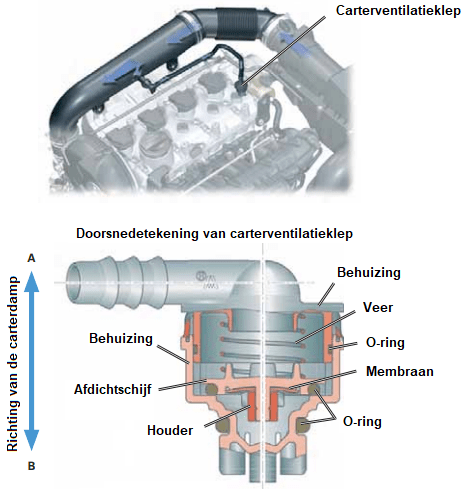
Blow-by gases:
The gases that enter the crankcase from the combustion chamber are called blow-by gases. Blow-by gases can enter the crankcase in many ways. Factors such as piston clearance, the condition of the piston rings and the ovality and wear of the cylinder wall have the most influence on the amount of blow-by gases produced by an engine.
During combustion, approximately one kg of water vapor is produced per liter of fuel, part of which ends up in the crankcase along the piston rings.
During the warm-up of a cold engine and a rich mixture with acceleration, most blow-by gases are created, which means that unburned or incompletely burned fuel ends up in the crankcase. The blow-by gases consist of 10 to 40% oil and the rest of gases such as H20, CO, Co2, HC and NOx.
Versions of crankcase ventilation and crankcase ventilation:
The images show a part of the engine block in which the type of crankcase breather can be recognized. The crankcase breather components are identified by pneumatic symbols.
The legend shows the meanings of the symbols.
Each type of crankcase breather is numbered (from 1 to 7).
1. unregulated crankcase breather with gas valve drain:
The crankcase breather consists of an oil separator and a hose to the air hose between the air filter and the gas valve. This is the simplest version of the crankcase breather that we come across in passenger cars. There are many drawbacks to this construction:
– the crankcase vapors can damage the air mass meter to pollute;
– the vacuum in the crankcase depends on the air filter resistance.
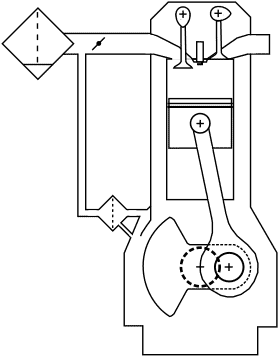
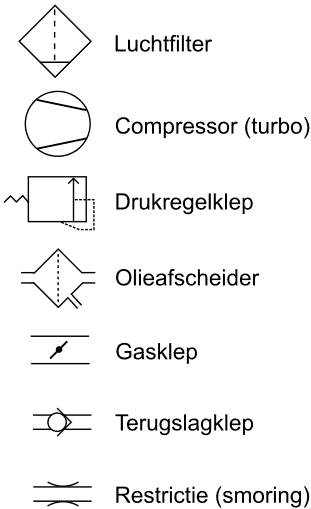
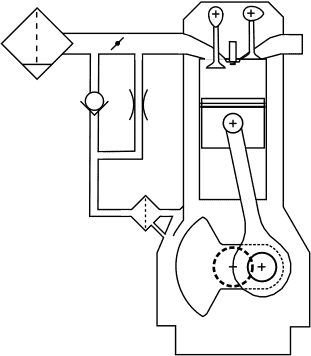
2. crankcase breather with non-return valve before, and restriction after the gas valve:
Compared to number 1 (above), there is better venting, because in partial load there is a better airflow over the throttle. One drawback is that the construction is more complicated than number 1.
3. crankcase ventilation with flow direction change in the ventilation pipe:
The big plus is that this involves ventilation in the crankcase, and not just venting. Disadvantages are that a second oil separator is required and the air flow in the oil separator is reversed.
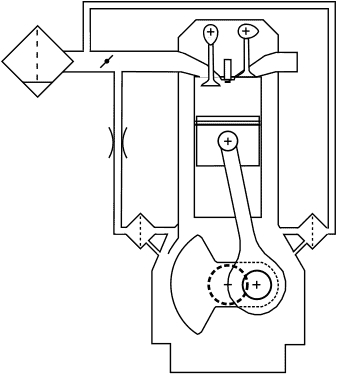
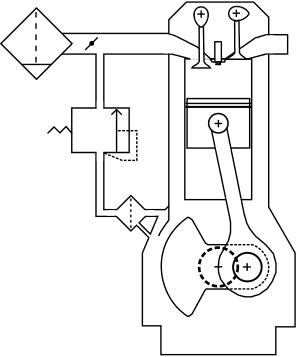
4. controlled crankcase ventilation with discharge after the gas valve:
Because this version is located after the gas valve, there is more underpressure in the crankcase vent (a more suction effect). A pressure regulator is therefore required. Between the oil separator and the inlet pipe is a pressure regulator that only opens at a certain crankcase pressure. Without overpressure in the crankcase, the pressure regulator is closed.
5. controlled crankcase ventilation system with exhaust for the gas valve:
We also see the pressure regulator in this version. The addition in this system is the hose between the air intake pipe before the gas valve and the connection on the valve cover. This allows ventilation. The downside is that there is false air over the throttle.
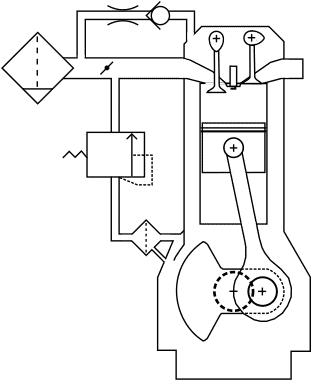
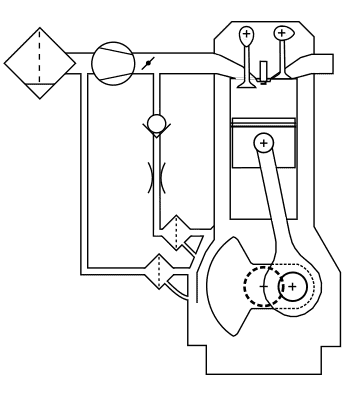
6. unregulated crankcase ventilation of a supercharged engine:
There is a check valve in the crankcase breather hose between the throttle valve and the intake manifold. This prevents the turbo from blowing an overpressure in the crankcase ventilation system. Under full load conditions, this pressure relief valve would remain closed and the crankcase pressure would rise too high. For that reason, an extra oil separator with a hose is attached to the suction side of the turbo.
7. Controlled Crankcase Ventilation System of a Supercharged Engine:
The hose to the valve cover allows crankcase ventilation. The pressure control valve with two non-return valves allows a higher vacuum for the oil separator. The downside is that this system is complex.
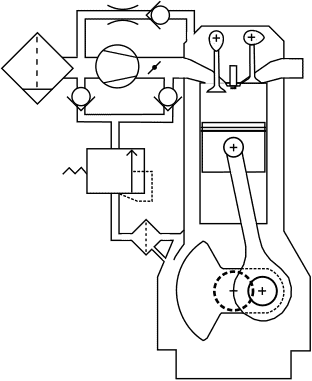
Oil separators:
Manufacturers use oil separators to prevent engine oil from being sucked into the intake duct with the blow-by gases via the crankcase ventilation. Without an oil separator, components such as the air mass sensor, turbo, the valves and the catalytic converter or particulate filter could become dirty or damaged. As the name suggests, the oil separator separates air and oil residues from each other. Oil separators exist in different versions: the cyclone, labyrinth and electrolytic oil separator. These three embodiments are described in the following paragraphs.
Cyclone oil separator:
The cyclone oil separator separates the oil and air in the crankcase vapors by swirling the air. Due to the centrifugal force created during the vortex, the heavier oil particles are thrown against the inside of the housing.
The oil droplets that remain are returned to the crankcase via a hose. The air pushes up the pressure control valve against the spring force and is fed to the engine inlet. In the picture we see that the turbo sucks in this air.
The pressure control valve closes when a vacuum threatens to form in the crankcase, for example when the turbo takes in a lot of air. Too high a vacuum in the crankcase could damage gaskets and seals.
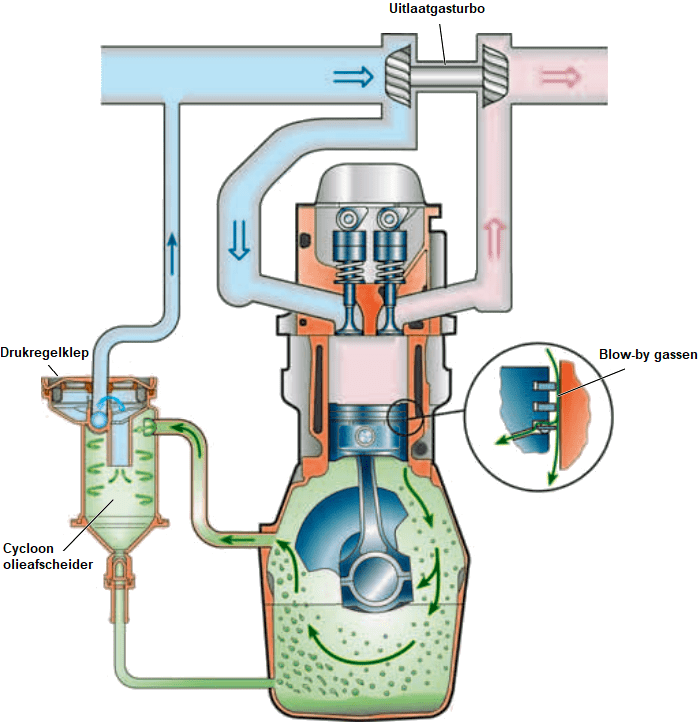
Labyrinth oil separator:
A labyrinth oil separator is often combined with a cyclone separator. In the labyrinth oil separator, the crankcase vapors collide with the bulkheads. The oil droplets are separated from the air and fall back into the crankcase. The remaining oil residues are then separated from the vapor in the cyclone separator.
With increased crankcase pressure and excessive crankcase vapors, for example as a result of excessive wear on the piston rings, the pressure limiting valve opens to prevent the crankcase pressure from rising too high.
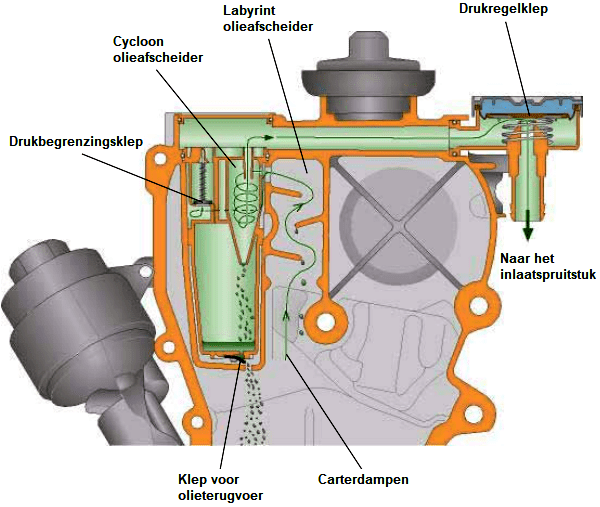
The images below show a valve cover of a 2.0 TDI VW engine. Both types of oil separators are mounted in the valve cover.
The images below show the positions of the labyrinth and cyclone oil separators. The crankcase vapor enters the labyrinth (left). In the labyrinth, the coarse oil residues are separated from the air flowing through. From the labyrinth, the crankcase vapor enters the cyclone section to remove the last oil residues from the air.
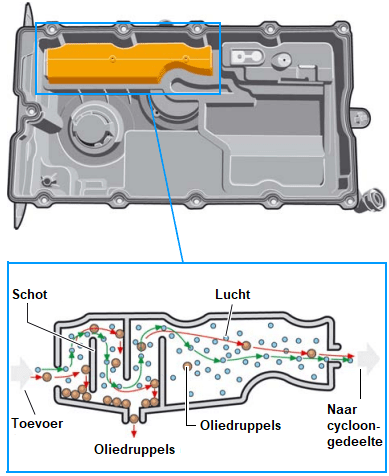
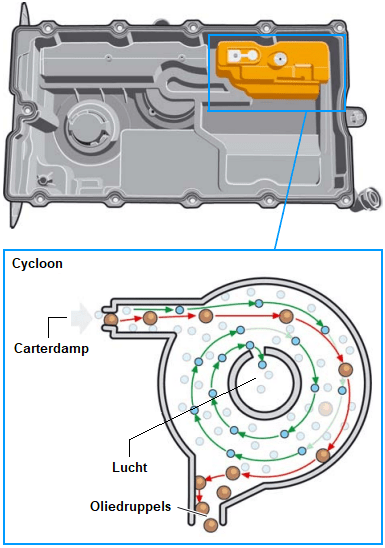
Electrostatic Oil Separator:
The previously mentioned oil separators do not achieve 100% effective separation. When the crankcase vapor passes through these types of oil separator at low speed, as we can avoid at low speed, small oil droplets still remain in the vapor. The electrostatic oil separator also removes these small droplets from the crankcase vapors. The cleaned crankcase vapor contains less than one percent of the oil that entered the uncleaned crankcase vapor.
The following figure shows the electrostatic oil separator.
High voltage also makes the smallest oil droplets magnetic, so that they stick in the separator. In this way the oil is separated from the air.
The housing contains a transformer that converts the on-board voltage of 12 or 24 volts (in a passenger or commercial vehicle) to a high voltage of 9 to 12 kilovolts.

Electric heater for crankcase breather:
The crankcase vapor contains water vapor. In the section “blow-by gases” it was already described that about one kg of water vapor is released per liter of fuel, part of which ends up in the crankcase along the piston rings. With a cold engine where the temperature in the crankcase breather is less than 70 degrees Celsius, the water vapor will condense as water. During many cold starts and short trips, a large amount of water collects in the engine block.
While the engine is running, some of the moisture evaporates and the vapor is discharged through the crankcase vent. The crankcase vapor condenses on the colder areas in the engine components, including the crankcase breather hoses. To prevent the vapor in the hose from freezing at low outside temperatures, many car manufacturers install one or more heating elements in a crankcase breather hose.
The heater is activated by the ECU during a cold start.
In engines without a heating element, or where the heating does not function, there is a risk that the breather hose will freeze. This is where a blockage occurs. The crankcase pressure is then considerably higher. As a result of the increased crankcase pressure, oil leakage can occur through the crankshaft seal or gaskets (valve cover or sump pan gasket).
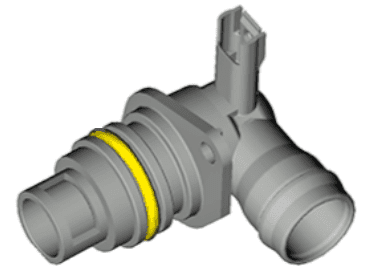
Engines that do not reach operating temperature enough can freeze the water in the sump. Because oil floats on water, the ice blocks the flow of oil into the oil screen. The low oil pressure causes engine damage. The electric heating described in this section does not offer a solution for this: the heating prevents freezing of the crankcase ventilation hoses that can be located at the top of the engine compartment. To prevent a lot of water from collecting in the crankcase, it is good to let the engine warm up often by making long trips, not to postpone maintenance intervals and to avoid short trips of several kilometers as much as possible.
Common crankcase ventilation issues:
- Clogged crankcase ventilation: High pressure builds up in the crankcase and hinders engine operation. In engines with a lot of white sludge (oil residue with moisture, from always driving short distances where the engine never gets up to temperature, or due to a defective thermostat), the crankcase breather can become completely clogged. The hoses are then full of sludge, and can freeze in the winter (because white sludge usually consists of moisture). If this happens, the hoses may spontaneously split apart.
- Cracked hoses: oil attacks rubber. There are oil residues in crankcase vapors and the hoses to the inlet are often made of rubber. As these snakes get older they can tear. These hoses often feel like chewing gum in advance and is an indication that they need to be replaced.
- A ruptured crankcase ventilation hose can cause an unpleasant oil smell in the engine compartment and thus also in the interior. The engine will also suck in false air, because the extra air drawn in has not been measured by the air mass meter. Excess air can cause the engine to run erratically, consume more fuel and cause the engine light to illuminate.
- Dirty engine: crankcase vapors can still contain small oil droplets despite oil separators. This can contaminate the engine's intake tract, including the throttle body and intake valves.
- Increased crankcase pressure: This is not a problem with the crankcase ventilation itself, but can be observed through the vent. When a lot of air is blown through the crankcase ventilation, it is possible that one or more (compression) piston rings or the cylinder wall are damaged. The mixture leaks past the piston rings to the crankcase during the compression stroke (blow by). A compression test or a cylinder leak test must be performed to determine whether the cause is the piston rings. In an engine that suffers from this, the engine oil will become dirty and age faster due to the fuel and combustion gases.
